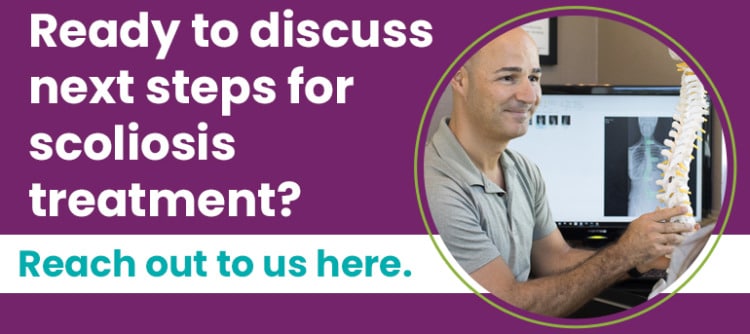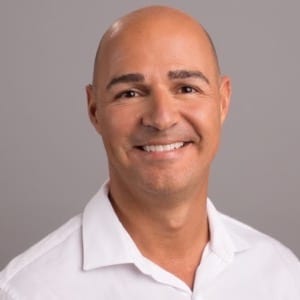Myrtle Beach SC Scoliosis Treatment: Non-Surgical Solutions
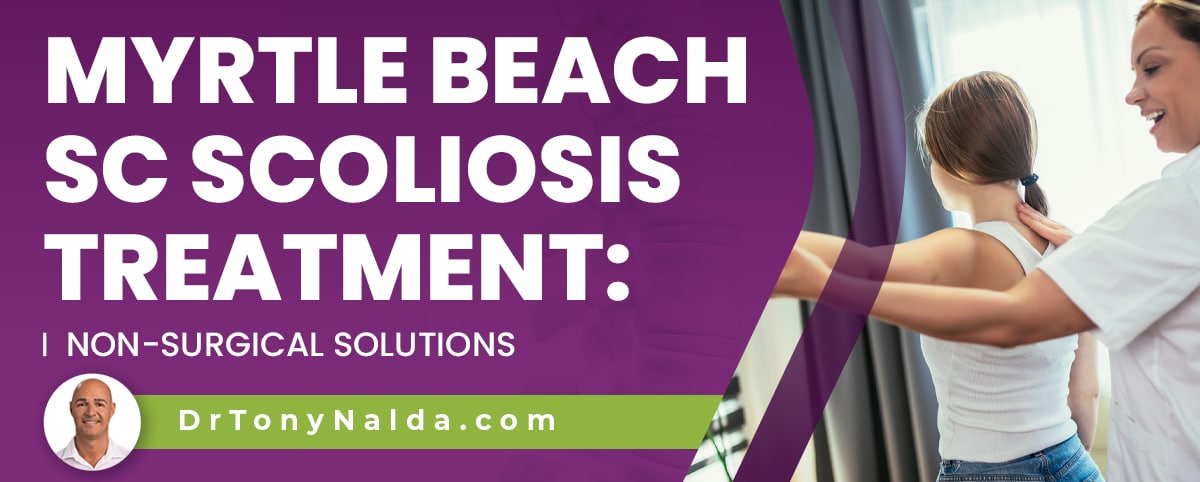
To understand scoliosis, knowing its causes, effects, and treatment options is important. Not only does scoliosis range widely in severity, there are also different condition types with unique characteristics and treatment needs. Regardless of severity or type, the most important decision patients have to make is how to respond to a diagnosis with treatment.
A 2-hour flight from Myrtle Beach SC to Orlando, Florida can make Dr. Tony Nalda's Scoliosis Reduction Center® accessible to Myrtle Beach residents. Known for its innovative non surgical treatments for scoliosis, the Center's results show that not all cases of scoliosis need surgery.
Treatment plans are shaped around key patient/condition variables such as patient age, condition severity, type, and curvature location.
Table of Contents
Diagnosing Scoliosis: Early Detection
Diagnosing scoliosis means an unnatural spinal curve has developed, and as a 3-dimensional condition, the curve also twists unnaturally.
Diagnosing scoliosis involves further classifying conditions based on key variables that treatment plans are shaped around.
Patient age is important not just because it indicates a person's overall level of health, but because as a progressive condition triggered by growth, young patients are more at risk for rapid phase progression.
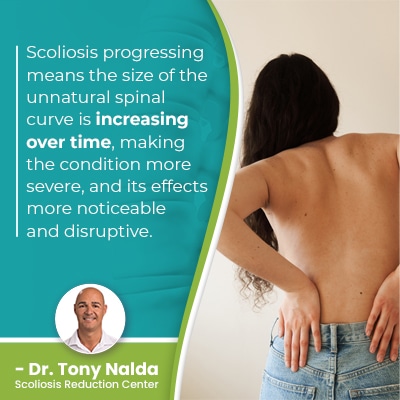 Scoliosis progressing means the size of the unnatural spinal curve is increasing over time, making the condition more severe, and its effects more noticeable and disruptive.
Scoliosis progressing means the size of the unnatural spinal curve is increasing over time, making the condition more severe, and its effects more noticeable and disruptive.
Patient age is also important because as scoliosis doesn't become a compressive condition until skeletal maturity has been reached, this is when it commonly becomes painful, and a treatment focus will include pain management.
Scoliosis pain is the main symptom of adult scoliosis that leads to a diagnosis, and childhood scoliosis is commonly diagnosed because of related postural changes.
Childhood Scoliosis Effects: Posture
While scoliosis also affects adults, children are more commonly diagnosed, and the most prevalent type of scoliosis overall is adolescent idiopathic scoliosis diagnosed between the age of 10 and reaching skeletal maturity.
Scoliosis introduces a lot of uneven forces to the spine, its surroundings, and the entire body, and in children, the earliest signs often involve postural changes such as uneven shoulders and hips.
Additional postural changes can include uneven shoulder blades, the development of a rib cage arch, arms and legs hanging at different lengths, and these changes are associated with ill-fitting clothing and disruptions to balance, coordination, and gait.
In most cases, the area of the body located the closest to an affected spinal section is going to feel the majority of its direct effects, so curvature location helps indicate the types of symptoms a patient can face.
Curvature location can involve the cervical spine (neck), the thoracic spine (middle/upper back), and the lumbar spine (lower back).
Condition severity is a key characteristic that treatment plans are shaped around, and it's determined by a measurement obtained during X-ray.
Condition Severity and Cobb Angle
Scoliosis ranges widely in severity from mild scoliosis to moderate scoliosis, severe and very severe scoliosis; this is also the condition's progressive line.
As a progressive condition, scoliosis is not static; where a person's condition is at the time of diagnosis doesn't indicate that's where it will stay, especially if left untreated or not treated proactively.
A patient's Cobb angle is determined during X-ray and classifies conditions as mild, moderate, severe, or very severe.
The measurement is the gold standard in the assessment of scoliosis and involves drawing lines from the tops and bottoms of the curve's most-tilted vertebrae, and the intersecting lines form an angle that's expressed in degrees.
The higher a patient's Cobb angle, the more unnaturally tilted its vertebrae are, the further out of alignment the spine is, and the more complex the condition will be to treat, hence the benefits of proactive treatment that works towards preventing progression.
Preventing progression can also mean preventing increasing effects and the need for surgical intervention in the future.
- Mild scoliosis is diagnosed with Cobb angle measurements of between 10 and 25 degrees
- Moderate scoliosis is diagnosed with Cobb angle measurements of between 25 and 40 degrees
- Severe scoliosis involves measurements of 40+ degrees, and very-severe scoliosis is diagnosed at 80+ degrees
In addition to condition severity, determining condition type is important, and this involves a condition's underlying cause.
Condition Type and Causation
There is an important distinction to be made between addressing a condition's symptoms and addressing the underlying cause of a condition's symptoms: the condition itself.
When it comes to scoliosis, causation isn't always clear; in fact, in approximately 80 percent of known diagnosed cases, the cause is unknown, and this is classified as idiopathic scoliosis.
Idiopathic scoliosis is the most prevalent type to affect all ages.
Idiopathic scoliosis is thought to be multifactorial: caused by a number of different variables, and combinations of variables, that can vary from person to person.
The remaining 20 percent of known cases are associated with known causes and are considered typical and are often more complex to treat: neuromuscular scoliosis, degenerative scoliosis, and congenital scoliosis.
Neuromuscular Scoliosis
Neuromuscular scoliosis patients are among the most complex to treat, and this is because the scoliosis has developed as a secondary complication of a larger neuromuscular condition like spina bifida, muscular dystrophy, or cerebral palsy.
As the larger neuromuscular disease has caused the scoliosis, this complicates the treatment process; the larger condition has to be the focus of treatment.
Neuromuscular conditions cause a disconnect between the brain and the muscles, ligaments, and connective tissues that support the spine, making it vulnerable to the development of an unnatural spinal curve.
Degenerative Scoliosis
Degenerative scoliosis is caused by natural age-related spinal degeneration and the cumulative effect of certain lifestyle factors.
Degenerative scoliosis is often associated with degenerative disc disease as most spinal degeneration starts in the discs.
South Carolina scoliosis treatment can include Florida's innovative treatment center, where a focus of degenerative scoliosis treatment is on improving the spine's balance, support, and stability.
Congenital Scoliosis
Congenital scoliosis affects babies born with the condition due to a malformed spine that develops in utero.
In some cases, vertebral bodies fail to form into separate and distinct bones, instead becoming fused together as one solid bone, and other times, vertebrae are more triangular in shape, and this disrupts the spine's ability to form in a straight and neutral alignment.
Scoliosis Reduction Center®: Non Surgical Treatments
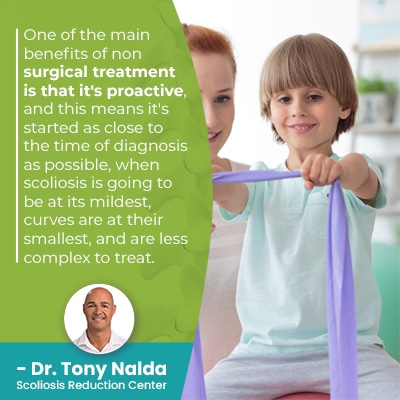 When it comes to being diagnosed with scoliosis, regardless of severity or type, the most important factor is the type of treatment applied.
When it comes to being diagnosed with scoliosis, regardless of severity or type, the most important factor is the type of treatment applied.
One of the main benefits of non surgical treatment is that it's proactive, and this means it's started as close to the time of diagnosis as possible, when scoliosis is going to be at its mildest, curves are at their smallest, and are less complex to treat.
As scoliosis progresses, the spine becomes increasingly rigid, making it less responsive to treatment, and the more established the condition's effects become, the harder they can be to reverse.
Non surgical treatment is also integrative, so for Myrtle beach patients who undertake the 2-hour flight to Dr. Tony's Orlando treatment center, they benefit from accessing a number of different treatments under one roof.
Chiropractic medicine and care is at the center of non surgical treatment as it's the condition's underlying structural nature that primarily needs to impacted with treatment; curvature reductions can be worked towards through a series of manual adjustments that reposition a curve's most-tilted vertebrae back into alignment with the rest of the spine.
Structural changes need to be supported and stabilized, however, and this is where physical therapy and postural-correction exercises can help,
Improving the balance and strength of the spine's surrounding muscles is a key facet of non surgical scoliosis treatment.
For childhood scoliosis, corrective bracing is another key facet that can help by pushing the spine into a corrective position, and bracing is often used for short-term pain management through providing stability in adult scoliosis.
Rehabilitation can involve continued chiropractic care and the prescription of scoliosis exercises capable of further healing and stabilizing the spine.
Conclusion
For Myrtle Beach SC residents willing to undertake a 2-hour flight, Orlando, Florida's innovative non surgical Scoliosis Reduction Center® is within reach, along with its impressive results.
While spinal fusion can still have a place in the treatment of severe, very severe, and atypical cases of scoliosis, the reality is that many cases of scoliosis respond to non surgical treatment that doesn't involve the same types of potential risks and side effects.
Non surgical treatment can preserve as much of the spine's natural strength and function as possible for the best quality of life moving forward.
Treatment for scoliosis should be proactive and integrative because this is what the condition's complex nature responds to, and its highly-variable nature necessitates the complete customization of treatment plans.
Non surgical scoliosis treatment is about addressing scoliosis proactively in a way that's most aligned with the spine's natural movement-based design, so don't hesitate to contact the Center for a consultation.
Dr. Tony Nalda
DOCTOR OF CHIROPRACTIC
After receiving an undergraduate degree in psychology and his Doctorate of Chiropractic from Life University, Dr. Nalda settled in Celebration, Florida and proceeded to build one of Central Florida’s most successful chiropractic clinics.
His experience with patients suffering from scoliosis, and the confusion and frustration they faced, led him to seek a specialty in scoliosis care. In 2006 he completed his Intensive Care Certification from CLEAR Institute, a leading scoliosis educational and certification center.
About Dr. Tony Nalda
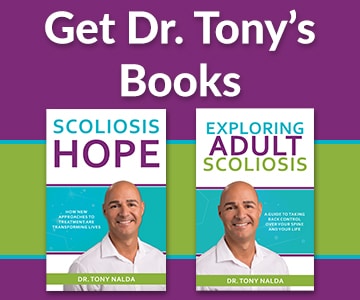 Ready to explore scoliosis treatment? Contact Us Now
Ready to explore scoliosis treatment? Contact Us Now